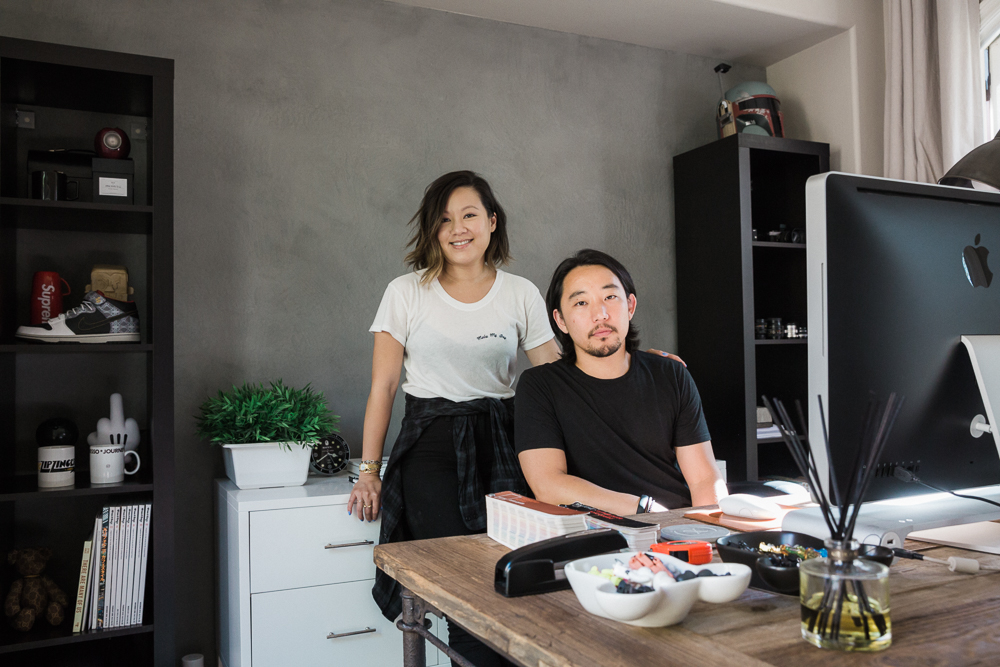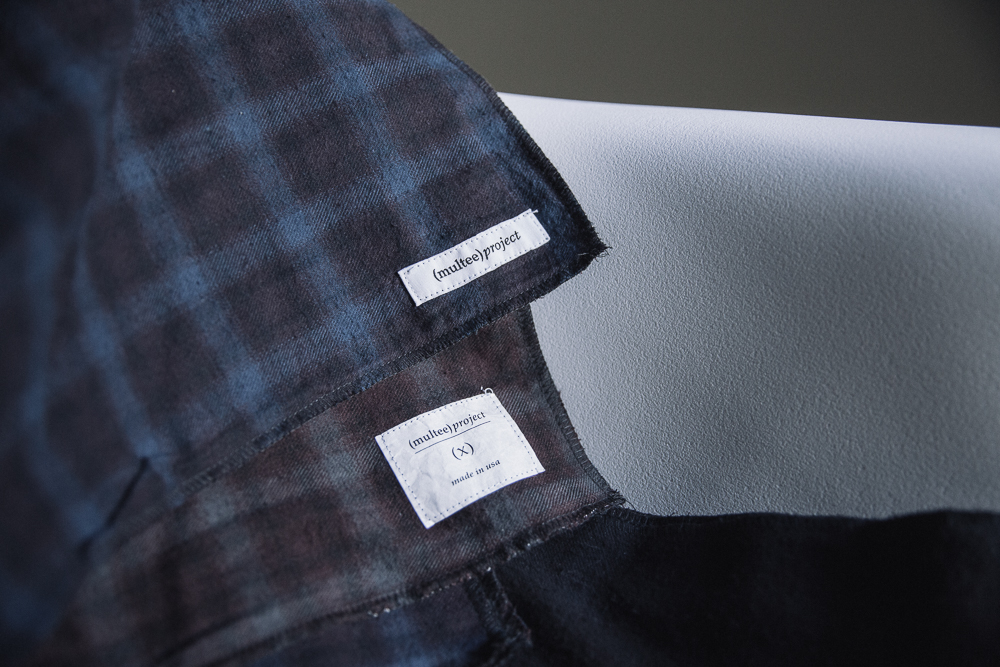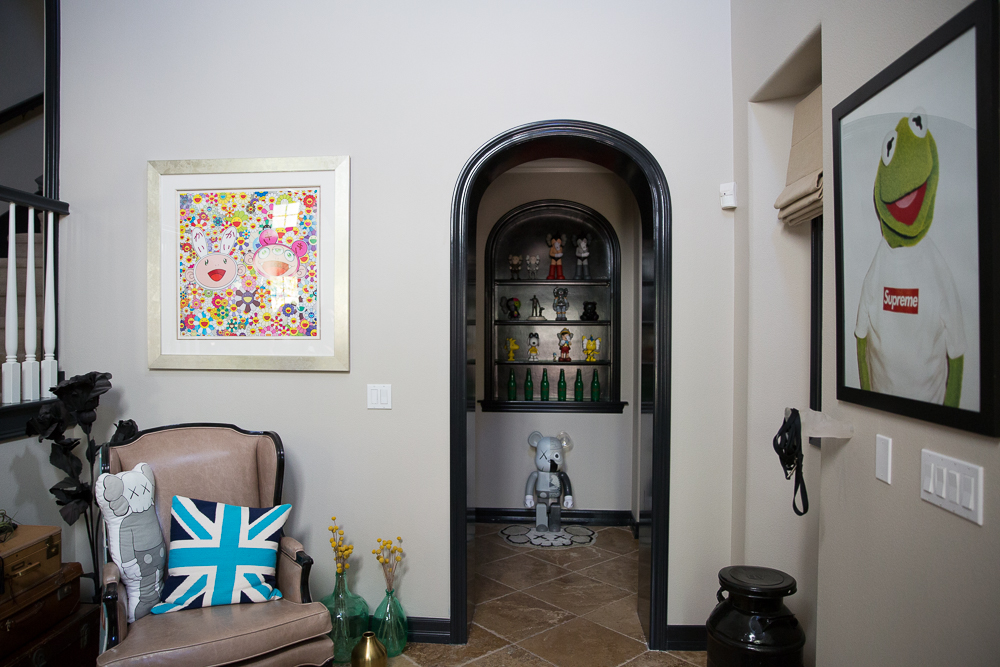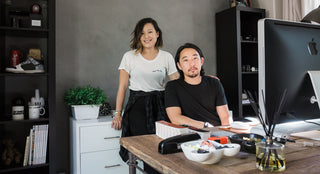Starting a business is no easy feat. It requires sacrifice, talent, and a little bit of luck. Tina Yang and Brian Chen, the husband and wife team of Multee Project, have found a way to grow their home-based business into something successful, while managing to find the balance between home life and work life to craft their creative designs and products. Multee Project is a part apparel, part accessory, and part lifestyle brand—living up to its name and keeping the duo behind this brand busy with new projects and never-ending possibilities. I spent an afternoon with the couple to talk about teamwork, inspiration, and the future for their brand.

What is your background?
BRIAN: I moved to California when I was 21 or 22. In Taiwan, I studied art and was a fine art major in high school. I wanted to continue to study design when I moved here. The goal was to get into film school at that time, but I was playing basketball about two or three times a week and one of my friends wanted to start a T-shirt company and needed a designer. I didn’t know how to design then, but I had Illustrator, so I told him that I think I could do [it] even though I’ve never designed anything before. At first it was three T-shirt graphics, then eight, then ten, and the whole thing took off and I dropped out of school and never went to film school. That’s how I got into this industry.
When did you make the decision to leave that brand to start Multee Project?
TINA YANG: When we first met, he wasn’t that happy at his company at that time. He started it in his early 20s and, by then, he was in his early 30s and didn’t wear the clothes that he designed.
You outgrow it.
TINA: Exactly. My background and my family’s background is in apparel and manufacturing, so I’ve grown up around that. I worked at the company for three years in Taiwan. One night, we sat down and I said, “We should do something together and you should design clothes that you love and are passionate about and proud of.” That’s where it all started. At first it wasn’t going to just [be] apparel. It’s “Multee Project,” so multiple projects that we could do. At that time it was very broad, we wanted to do coffee table books because we love buying books, then maybe do interior design, like home decor and furniture, just to keep it open. From our experience, we knew apparel better, so we decided to do apparel first.

Your first product was apparel then?
BRIAN: Our first product was a carabiner. After I designed the apparel, the production process took longer than expected. My carabiner broke at that time and I wanted to improve [it] and make something that I enjoy, so I made the carabiner. That production time was a lot faster than the apparel, so I had a bunch of carabiners [and] decided that we should start selling them. Some people know us only as an apparel company, but we actually started with an accessory.
What was your process and thought behind the initial carabiner? Why did you design it the way you did? Because there are obviously plenty of carabiner styles everywhere?
BRIAN: One thing that bugged me about other carabiners is that usually you put the spring inside, so after some use, the spring usually breaks or pops out. I got frustrated. I was thinking, “What if we put the spring on the outside and make it part of the design rather than an afterthought?”
It also holds better on your belt loop when in use. So not only does it look good, but there is a practical function behind it.
BRIAN: Right. For our Type-2 carabiner, we listened to feedback and made the new one lighter and attached three holes so we could attach three key rings. The reason we use the snap keyring is that these won’t break. We improved the quality and also switched our manufacturer.

You’ve worked with a couple different brands on the carabiners. How did you select the brands you decided to work with?
BRIAN: I’ve worked with Marcus Troy and Pete from Raised by Wolves on the carabiners. I try to work with people that I know and have gotten to know and that make a good fit. I’m quite selective on the people similar to retailers that we work with.
TINA: We like to work with people who have similar philosophies as us. It just makes working fun.
That’s refreshing to hear as many companies tend to collaborate for the sake of collaboration or to see how many units they can sell and how much money they can make.
BRIAN: Collaboration for me is working with friends. We bounce ideas around and we want to make something different than what they making and what we are already making and make something new. Otherwise, there’s no point if you just slap on a logo. There’s too many collaborations these days and it’s hard to stand out with so many collaborations.

Essentially, this is a two-person team. Do you have sales agents? How do you get your product to retail?
BRIAN: You’re looking at the sales agents. We pretty much do everything for ourselves, at least for now.
That controls quality and you know exactly where your product is distributed.
BRIAN: Right. We are quite selective on who carries our stuff.
TINA: I think that was something that Brian learned at his previous company—when you have a lot of accounts, things can get out of control.
Things can get watered down.
BRIAN: Yes and they can discount your product without telling you. At the end of the day, they don’t care about your image.
Where do you find your inspiration?
BRIAN: I find inspiration from personal experience and travel. For example, before we started Multee Project, I would travel a lot. I always hated how [when] I traveled and put my passport in my front or back pocket, it was too bulky. I try to solve those issues, so the first thing that I designed when we started Multee Project was a side pocket on my pants and it doesn’t get bulky. Another thing is that guys put their cell phone in their front or back pocket, but what bugged me was that the phone would roll around in your pocket because the pocket is a lot bigger than the phone. So for the pants, I added a small internal pocket for the iPhone so it wouldn’t roll around. I guess the way I design is based on what I would use for myself and hope that there is a similar mindset and people will like what I design.

Multee Project Fall 2013. Photo: hypebeast.com
Working together as a couple. How is that dynamic? I’m guessing there are some pros and cons.
TINA: I think we figured out early on that we shouldn’t work on the same thing because we both have graphic design backgrounds, but we do things very differently. Brian works from experience, so he’s a lot faster, whereas I went through the academics and I’m a lot slower. It’s very different and we learned that if we do the same thing at the same time, it’s no good. Now we focus on different things. At the end, he may ask me for my opinion or I may ask him, “Why did you do it like this?” or, “Why did you design this? Did you feel it’s something that’s missing?” So we balance things like that.
BRIAN: We work towards the same goal. We want to grow together and be successful together. There is no ego. There is no, “This is my company.”
At the end of the day, you’re “one.” With a traditional company you couldn’t have that. Not one of you work for each other, but together. From the design process to sales, you guys work on it all.
TINA: I do more of the marketing. Brian does all of the design. They are all his concepts—especially for menswear. Things like the candles and the scent collection, I have more input. Marketing, customer service, and social media I handle. It’s just us. Which is also a con. At times we try to schedule meetings and meet with other people and see things, because otherwise it’s just the two of us and we live in Orange County, so it’s a bubble. Working together, there is no starting at 8 and go home at 6—it’s work all the time.
BRIAN: Sometimes you have to balance it out. We work from home. It’s hard to balance out what’s work and what’s personal. The good part for me is that I really enjoy what I do. This is the industry that I love. If I wasn’t doing this, I would still be checking websites to see what’s new; a lot of times it doesn’t feel like working. [But] another con is that it can drag… especially on the weekends. She doesn’t like me checking my email on weekends.

Who would be a dream brand, artist, or any one that you could work with to collaborate with?
BRIAN: Bearbrick. I would really like to work with them.
What’s in the future?
BRIAN: We are working on a kids’ line, but not directly under Multee Project. There’s a lot people our age now having kids.
TINA: Ever since we started Multee Project we always knew we wanted to do another line. It was something we always talked about. Then last year we realized that we were always buying baby clothes. We were always attending baby showers and our friends around us were starting to have kids so we knew that was the next step.
***

